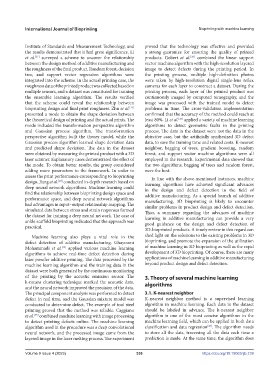Page 344 - IJB-9-4
P. 344
International Journal of Bioprinting Bioprinting with machine learning
Institute of Standards and Measurement Technology, and proved that the technology was effective and provided
the results demonstrated that it had great significance. Li a strong guarantee for ensuring the quality of printed
et al. surveyed a scheme to uncover the relationship products. Gobert et al. combined the linear support
[26]
[21]
between the design method of additive manufacturing and vector machine algorithm with the high-resolution layered
the roughness of the final product. Random forest, decision image to detect defects during the printing period. In
tree, and support vector regression algorithms were the printing process, multiple high-definition photos
integrated into the scheme. In the actual printing case, the were taken by high-resolution digital single-lens reflex
roughness data of the printed product was collected based on cameras for each layer to construct a dataset. During the
multiple sensors, and a dataset was constituted for training printing process, each layer of the printed product was
the ensemble learning algorithm. The results verified continuously imaged by computed tomography, and the
that the scheme could reveal the relationship between image was processed with the trained model to detect
bioprinting design and final print roughness. Zhu et al. problems in time. The cross-validation implementation
[22]
presented a mode to obtain the shape deviation between confirmed that the accuracy of the method could reach at
the theoretical design of printing and the actual prints. The least 80%. Li et al. applied a variety of machine learning
[27]
mode included the transformation perspective algorithm algorithms to detect geometric faults in the printing
and Gaussian process algorithm. The transformation process. The data in the dataset were not the data in the
perspective algorithm built the theory model, while the objective case, but the artificially synthesized 3D defect
Gaussian process algorithm learned shape deviation data data, to save the training time and related costs. K-nearest
and predicted shape deviation. The data in the dataset neighbor, bagging of trees, gradient boosting, random
were obtained by measuring the printed product with a 3D forest, and support vector machine algorithms were all
laser scanner. Explanatory cases demonstrated the effect of employed in the research. Experimental data showed that
the mode. To obtain better results, the group considered the two algorithms, bagging of trees and random forest,
adding more parameters to the framework. In order to were the best.
assess the print performance corresponding to bioprinting In line with the above-mentioned instances, machine
design, Jiang et al. conducted in-depth research based on learning algorithms have achieved significant advances
[23]
deep neural network algorithms. Machine learning could in the design and defect detection in the field of
find the relationship between bioprinting design space and additive manufacturing. As a special branch of additive
performance space, and deep neural network algorithms manufacturing, 3D bioprinting is likely to encounter
had advantages in input–output relationship mapping. The similar problems in product design and defect detection.
simulated data between stress and strain responses formed Thus, a summary regarding the advances of machine
the dataset for training a deep neural network. The case of learning in additive manufacturing can provide a very
ankle scaffold bioprinting indicated that the approach was good guidance on the design and defect detection of
practical. 3D-bioprinted products. A timely review in this regard can
Machine learning also plays a vital role in the shed light on the solutions to the existing problems in 3D
defect detection of additive manufacturing. Ghayoomi bioprinting, and promote the expansion of the utilization
Mohammadi et al. applied various machine learning of machine learning in 3D bioprinting as well as the rapid
[24]
algorithms to achieve real-time defect detection during development of 3D bioprinting. Of course, there are many
laser powder additive printing. The data processed by the applications of machine learning in additive manufacturing
machine learning algorithm and the training data in the beyond product design and defect detection.
dataset were both generated by the continuous monitoring
of the printing by the acoustic emission sensor. The 3. Theory of several machine learning
k-means clustering technique marked the acoustic data, algorithms
and the neural network improved the precision of the data.
The principal component analysis was performed to detect 3.1. K-nearest neighbor
defect in real time, and the Gaussian mixture model was K-nearest neighbor method is a supervised learning
conducted to determine defect. The example of tool steel algorithm in machine learning. Each data in the dataset
printing proved that the method was reliable. Caggiano should be labeled in advance. The k-nearest neighbor
et al. combined machine learning with image processing algorithm is one of the most concise algorithms in the
[25]
to detect printing defects online. The machine learning machine learning field, which can be applied in both data
algorithm used in the procedure was a deep convolutional classification and data regression . The algorithm needs
[28]
neural network, and the processed image came from the to store all the data, traversing all the data each time a
layered image in the laser melting process. The experiment prediction is made. At the same time, the algorithm does
Volume 9 Issue 4 (2023) 336 https://doi.org/10.18063/ijb.739

